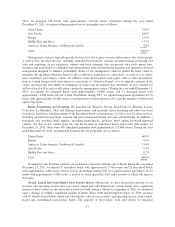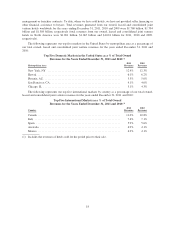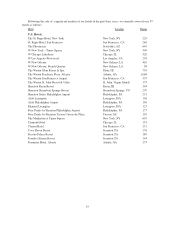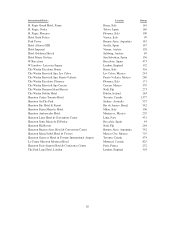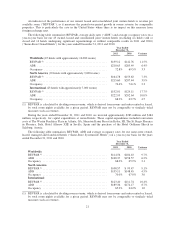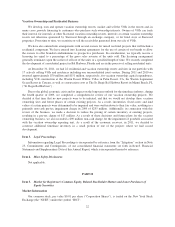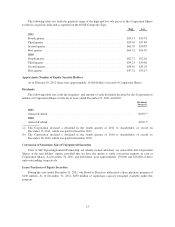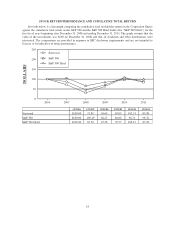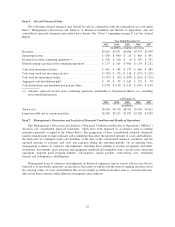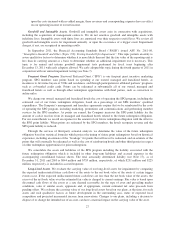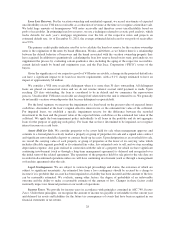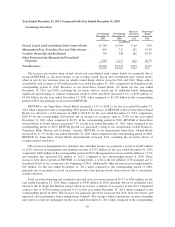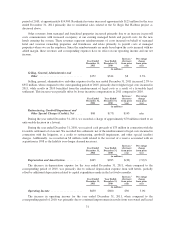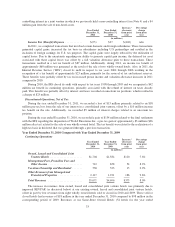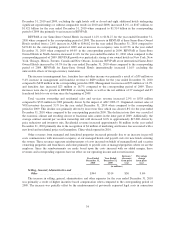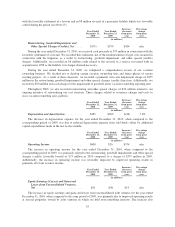Starwood 2011 Annual Report Download - page 95
Download and view the complete annual report
Please find page 95 of the 2011 Starwood annual report below. You can navigate through the pages in the report by either clicking on the pages listed below, or by using the keyword search tool below to find specific information within the annual report.upon the costs incurred with no added margin, these revenues and corresponding expenses have no effect
on our operating income or our net income.
Goodwill and Intangible Assets. Goodwill and intangible assets arise in connection with acquisitions,
including the acquisition of management contracts. We do not amortize goodwill and intangible assets with
indefinite lives. Intangible assets with finite lives are amortized over their respective useful lives. We review all
goodwill and intangible assets for impairment annually, or upon the occurrence of a trigger event. Impairment
charges, if any, are recognized in operating results.
In September 2011, the Financial Accounting Standards Board (“FASB”) issued ASU No. 2011-08,
“Intangibles-Goodwill and Other (Topic 350): Testing Goodwill for Impairment”. This topic permits an entity to
assess qualitative factors to determine whether it is more likely than not that the fair value of the reporting unit is
less than its carrying amount as a basis to determine whether an additional impairment test is necessary. This
topic is for annual and interim goodwill impairment tests performed for fiscal years beginning after
December 13, 2011 with early adoption allowed. We early adopted this topic during the fourth quarter of 2011 in
conjunction with our annual impairment testing (see Note 7).
Frequent Guest Program. Starwood Preferred Guest (“SPG”) is our frequent guest incentive marketing
program. SPG members earn points based on spending at our owned, managed and franchised hotels, as
incentives to first-time buyers of VOIs and residences, and through participation in affiliated partners’ programs
such as co-branded credit cards. Points can be redeemed at substantially all of our owned, managed and
franchised hotels as well as through other redemption opportunities with third parties, such as conversion to
airline miles.
We charge our owned, managed and franchised hotels the cost of operating the SPG program, including the
estimated cost of our future redemption obligation, based on a percentage of our SPG members’ qualified
expenditures. The Company’s management and franchise agreements require that we be reimbursed for the costs
of operating the SPG program, including marketing, promotions and communications and performing member
services for the SPG members. As points are earned, the Company increases the SPG point liability for the
amount of cash it receives from its managed and franchised hotels related to the future redemption obligation.
For our owned hotels we record an expense for the amount of our future redemption obligation with the offset to
the SPG point liability. When points are redeemed by the SPG members, the hotels recognize revenue and the
SPG point liability is reduced.
Through the services of third-party actuarial analysts, we determine the value of the future redemption
obligation based on statistical formulas which project the timing of future point redemptions based on historical
experience, including an estimate of the “breakage” for points that will never be redeemed, and an estimate of the
points that will eventually be redeemed as well as the cost of reimbursing hotels and other third parties in respect
of other redemption opportunities for point redemptions.
We consolidate the assets and liabilities of the SPG program including the liability associated with the
future redemption obligation which is included in other long-term liabilities and accrued expenses in the
accompanying consolidated balance sheets. The total actuarially determined liability (see Note 17), as of
December 31, 2011 and 2010 is $844 million and $753 million, respectively, of which $251 million and $225
million, respectively, is included in accrued expenses.
Long-Lived Assets. We evaluate the carrying value of our long-lived assets for impairment by comparing
the expected undiscounted future cash flows of the assets to the net book value of the assets if certain trigger
events occur. If the expected undiscounted future cash flows are less than the net book value of the assets, the
excess of the net book value over the estimated fair value is charged to current earnings. Fair value is based upon
discounted cash flows of the assets at a rate deemed reasonable for the type of asset and prevailing market
conditions, sales of similar assets, appraisals and, if appropriate, current estimated net sales proceeds from
pending offers. We evaluate the carrying value of our long-lived assets based on our plans, at the time, for such
assets and such qualitative factors as future development in the surrounding area, status of expected local
competition and projected incremental income from renovations. Changes to our plans, including a decision to
dispose of or change the intended use of an asset, can have a material impact on the carrying value of the asset.
27


